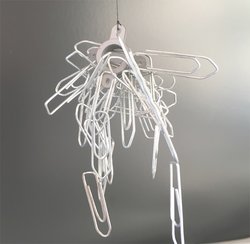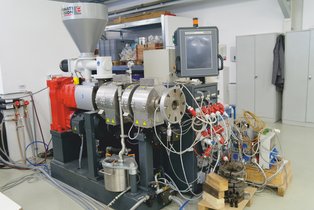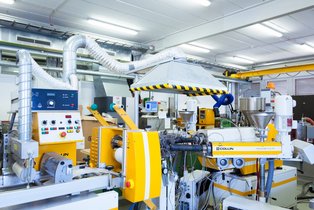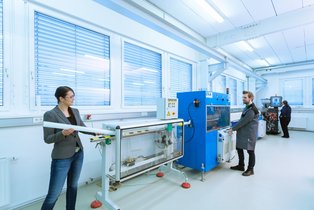Extrusion
Due to decades of experience in the field of extrusion we are able to design screws and dies by 3D-FEM simulations and analytical calculation. Furthermore, we are able to solve a wide variety of tasks through trials on the extrusion lines. This enables us to substantiate the simulation and calculation results with practical tests and to improve the methodologies.

SUSMAGPRO - Sustainable recovery, recycling and reuse of rare earth magnets
The aim of the SUSMAGPRO project is to identify, separate, process and reuse permanent magnets based on rare earths such as neodymium-iron-boron (NdFeB) on a pilot scale throughout Europe.
A circular business model is being developed in the spirit of the circular economy: Instead of sending the critical resources to landfills or exporting NdFeB-containing waste to other parts of the world, SUSMAGPRO will use the latest technologies to extract the elements from magnetic scrap and reintegrate the metals into new products for the European market via a shortened cycle. The focus is on applications in automotive rotors, water pumps, loudspeakers and wind turbines.
The Chair of Plastics Processing is involved in the project with the development, optimization and characterization of polymer NdFeB compounds that can be used for the production of sintered and bonded magnets via extrusion and/or injection molding.
Test your knowledge about rare earth magnets --> SUSMAGPRO QUIZ
to the factsheet
SUSMAGPRO is a successor project of:
REMANENCE project: cordis.europa.eu/project/rcn/106545/en
REProMag project: cordis.europa.eu/project/rcn/193433/factsheet/en
SUSMAGPRO is funded under the "Horizon 2020" research and innovation program of the European Union (Grant Agreement No. 821114). Project duration: 06/2019 - 05/2023 Participating countries: Austria, Denmark, Germany, Italy, Netherlands, Slovenia, Spain, Sweden, United Kingdom
Translated with www.DeepL.com/Translator (free version)
The FFG Coin project micro pelletizing involved the development of an underwater pelletizing technology for thermoplastic micro pellets for use in rotational molding.
For this purpose, extensive simulations were carried out at the chair on the pelletizing head of the company Econ, since the holes with diameters of 0.5 mm tend to freeze and thus become clogged. Furthermore, the die plate and also the flow concept of this underwater pelletizing system were revised in cooperation with various companies and universities.
This FFG funded project dealt with the procedural description of a co-rotating conical twin screw extruder from the company M-A-S (Maschinen und Anlagenbau Schulz GmbH). At the chair an analytical program for the calculation of the pressure at the die was developed and the results could be verified with measurements at the laboratory extruder at M-A-S.
With the conical geometry of the screws a very big free volume at the intake can handle bulk goods with a very low density. So materials like flakes from the recycling with a bulk density of about 300 kg/m³ can be processed. The pressure built up, increased by the conical concept enables a direct extrusion without the need of a melt pump.
In the feed zone of extruders the bulk material properties of the granules are very important. The density, the pressure anisotropy but also the friction between the material itself and to the surrounding machinery plays a vital role in conveying. As an example the density of PET flakes at different pressures was researched.
The pressure anisotropy, the relation of the radial to axial pressure can vary between zero and one and is dependent of the pressure and temperature.
The friction coefficient can be measured with the friction extruder. The pressure along the screw, the torque and the screw speed are measured and the friction coefficient between the bulk material and the cylinder can be calculated.
The FFG Bridge project was funded for the development of a method to measure the residence time measurement using a dielectrically tracer.
A tracer (lead zirconate titanate) is given in a pulse and the change of the capacity over the time is measured and leads to the residence time distribution. Different dies were constructed in which the capacitor plates are integrated. The frequency of the charging is directly proportional to the concentration of the tracer in the melt flow. In the figure three residence time distributions are shown. With an increase of the screw speed the residence time diminishes, while an increase of the tracer amount only shows the influence on the frequency (concentration).
In addition to analytical calculations screws, dies and tools are also designed with 3D fluid and structural simulation.
Both methodes use the equation of state. For flow problems the programm Ansys Polyflow is used. At the chair of polymer processing programs for single and twin-screw extruders but also for reciprocating screws were developed.
For the calculation of dies the viscoelastic properties of the polymer are a major challenge.
Weitere Anlagen
- Gleichlaufender hochtemperatur Doppelschneckenextruder
Leistritz ZSE 18HP-48D - Konischer gegenlaufender Doppelschneckenextruder
battenfeld-cincinnati Konos 38RP - Filtertestsystem Collin FT-E20T-MP-IS
- Reibwertmessextruder
- Blasformanlage Kautex
Maschinenbau KEB 1 - Thermoformmaschine
Illig UA 60 EDH OST G


